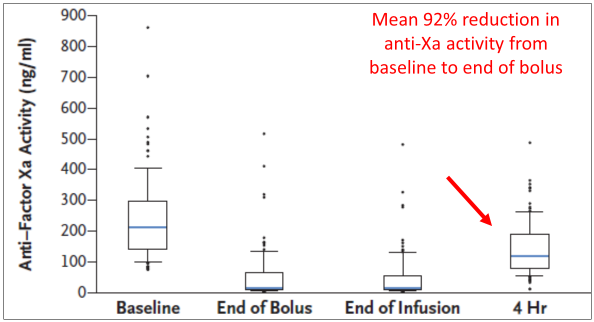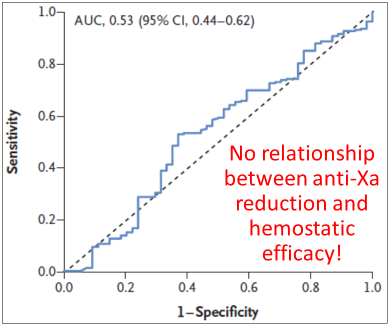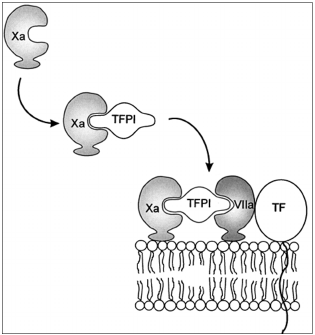HTRS 2019 Conference Summary
Posted on: June 25, 2019
David L. McGlasson, MS, MLS(ASCP)
Posted: June 25, 2019
On May 9-11, 2019 the Hemostasis Thrombosis Research Society (HTRS) and North American Foundation of Thrombosis and Hemostasis (NAFTH) met in New Orleans, LA for a large Clotting and Bleeding Clam Bake of clinical and research information sharing.
The first large exchange of information was that the two societies of HTRS/NAFTH would now merge under the banner of the HTRS for future meetings and business. This will result in more beneficial exchange of supporting collaborative research.
The first education session was a lively discussion on DOAC Reversal in a Bleeding Patient: Yes or No.
A case was presented of a subject suffering from a hemorrhage while undergoing a colostomy.
The audience was asked to vote via meeting APP as to whether they would use the anti-Xa reversal agent for a subject experiencing a severe hemorrhage while on an anti-Xa medication. The reversal agent in question to be used was Andexanet-alfa. The primary questions are: do the lab results correlate with the bleeding? Is the reversal agent really necessary?
The Pro reversal position was defended by Dr. Deborah Siegal, MD, MSc, FRCPC, Assistant Professor, Division of Hematology and Thromboembolism, Department of Medicine, Investigator, Population Health Research Institute, McMaster University, Hamilton, Ontario. The title of her presentation was DOAC reversal: the case for “Yes.”
Her talking points were the following:
- Bleeding is the major complication of DOACs and all anticoagulants including the Vitamin K agonists (VKA’s) like warfarin
- Major bleeding is associated with a risk of death
- DOACs are reversible
- Reversal agents are available
- Reversal will improve clinical outcomes (at least in some patients)
I noticed that her last bullet said in some patients. When talking about reversal of DOACs the medical community is still conflicted about when to reverse the medications. We don’t yet have a reference range that tells us when we should reverse a DOAC or if the laboratory values in a subject that is bleeding will really do anything other than let the healthcare team know that the drug is present and is it safe or not to reverse the suspected DOAC problem.
She noted that anticoagulants don’t cause bleeding but they make bleeding worse. She cited Dr. Mark Crowther, MD, with this quote. She then quoted Dr. Clive Kearon, MD on his “First Rule of Thrombosis,” “Don’t anticoagulate a bleeding patient.”
Dr. Siegal then made the points stated below:
When to Consider Using an Antidote in a Bleeding Patient:
- Life-threatening (e.g. hemodynamic compromise)
- Critical organ (e.g. intracranial)
- Severe ongoing bleeding
- Expected long delay in restoration of normal hemostasis (over-anticoagulation, renal failure)
Dr. Siegal then brought up the following issues for reasons on why reverse the DOAC present that is causing the bleeding:
- Remove anticoagulant effect
- Facilitate definitive interventions (endoscopy/surgery)
- Reduce complications of bleeding
- Anemia, transfusion, ICU admission, prolonged admission
- Save lives?
It was stated that GI bleeding is not a benign condition. She highlighted a couple of studies on using reversal agents for bleeding in dabigatran
REVERSE-AD GI Bleed Cohort (idarucizumab for dabigatran reversal) Hemostasis 69% Median time to bleeding cessation 2.4 hrs (2.0-3.9 Mortality – 30 days – 90 days 11% 15% Van der Wall Circulation 2019; Siegal Circulation 2019).
The second study was the ANNEXA 4 study using Andexanet alfa.
ANNEXA-4: Hemostasis and Corrected Anti-Xa Activity Connolly et al. NEJM 2019. Acute major bleeding ≤ 18 hours of last dose of apixaban, rivaroxaban, edoxaban, enoxaparin Efficacy n=254, Safety n=352 82% achieved good/excellent hemostasis within 12 hrs
Limitations of Data = Uncertainty in Lack of comparator group
- Hemostatic efficacy
- Thrombotic events
- Mortality
Therefore, does the Harm outweigh the benefits to use the reversal agents.
Dr. Siegal then summarized using PCC vs Andexanet alfa in 3 different studies:
| Majeed 2017 (N=84) | Schulman 2018 (n=66) | Connally 2019 (Efficacy= 254; Safety=352) | |
| Design | Cohort, prospective enrollment, retrospective data collection | Cohorts, prospective, no protocol | Cohort, prospective |
| Treatment | 4F-PCC | 4F-PCC | Andexanet |
| Time from FXa inhibitor | 12 hrs | 17 hrs | 12 hrs |
|
Hemostasis, (n%) Excellent/Good |
43(73) | 25(69) | 208(82) |
| Thromboembolism n(%) | 3(4) | 5(8) | 34(10) |
| Death, n(%) | 37(32) | 9(14) | 49(14) |
Majeed et al, Blood. 2017;130(15):1706-1712 Schulman Thromb and Haemost 2018 118(12):2188;. Connolly et al: N Eng J Med 2019;380(14):1326-1335.
The speaker then quoted what the experts say including surprisingly her “foe” Dr. Cuker et al in an article Reversal of direct oral anticoagulants: Guidance from Anticoagulantion Forum in Am J Hematol 2019;94:697-709.
In summary the experts said:
“We suggest administration of a reversal agent only if bleeding is life-threatening, into a critical organ or is not controlled with maximal supportive measures and there is reasonable expectation that the patient has clinically relevant plasma DOAC levels”.
“In patients with rivaroxaban-associated or apixaban-associated major bleeding in whom a reversal agent is warranted… we suggest treatment with andexanet alfa… If andexanet alfa is not available, we suggest treatment with four-factor PCC 2000 units”.
Dr. Siegal then gave her case for DOAC Reversal: The Case for “Yes”
- DOACs increase bleeding
- Bleeding kills patients
- DOACs are reversible
- Antidotes completely reverse DOACs
- Reversal will improve clinical outcomes
- A life is worth more than the cost of these drugs
- Judicious use is essential!
The position not to reverse was presented by Adam C. Cuker, MD, MS, Physician, Assistant Director, Hematology/Oncology Fellowship Program Clinical Director, Penn Blood Disorders Center, University of Pennsylvania Director, Penn Comprehensive and Hemophilia Thrombosis Program Assistant Professor of Medicine in Pathology and Laboratory Medicine Assistant Professor of Medicine at the Hospital of the University of Pennsylvania.
Dr. Cuker opened his reversal arguments by stating 3 positions to determine the reversal of the DOAC problems. They are 1. Efficacy, 2. Safety, and 3. Cost:
The ANNEXA-4 study
The ANNEXA-4 study design
Patients with major bleeding on a FXa inhibitor (n=352)
|
Andexanet bolus ————-> |
Coprimary endpoints:
|
No control group!
Connolly et al., N Engl J Med 2019;epub ahead of print
Reduction in anti-Xa activity

Connolly et al., N Engl J Med 2019;epub ahead of print
Clinical hemostasis

Connolly et al., N Engl J Med 2019;epub ahead of print
Relationship between anti-Xa and hemostasis
 Connolly et al., N Engl J Med 2019;epub ahead of print |
 |
Mortality
| Study (n) | Intervention | 30-day mortality |
| ANNEXA-4 (n=352) | Andexanet | 14% |
| Canadian real-world study from the pre-antidote era (n=460) | Standard of care
|
12.6% |
Connolly et al., N Engl J Med 2019;epub ahead of print; Xu et al., Chest 2017;152:81
The case for “no”
| I. Efficacy |
II. Safety
III. Cost
There are not well established ranges for situations in which the levels of DOACs should be reversed. I asked both Dr. Siegal and Dr. Cuker this question. They both replied that they may not know what to do with the actual concentration information. They would know the medication is present and depending on the condition of the patient’s bleeding state they then would make a decision on reversal.
Andexanet alfa’s efficacy is not well-established
- There was no control group in the ANNEXA-4 study
- There was no relationship between reduction in anti-Xa activity and achievement of hemostasis
- There was no reduction in mortality compared with the pre-antidote era
The case for “no”
I. Efficacy
| II. Safety |
III. Cost
Andexanet may be prothrombotic
| Study | Intervention | 30-day thrombotic range |
| ANNEXA-4 | Andexanet alfa | 10%* (40 events in 34 patients) |
| REVERSE-AD | Idarucizumab | 4.8% |
*MI (n=7), TIA/Stroke (n=15), VTE (n=18)
*11 events occurred within 5 days
*8 events occurred after resumption of anticoagulation
Connolly et al., N Engl J Med 2019;epub ahead of print; Pollock et al., N Engl J Med 2017;377:431
Andexanet may be prothrombotic

Siegal et al., N Engl J Med 2015;373:2413
Larry Brace, PhD., Medical Director of Special Coagulation Consultants Laboratory in Des Plaines, IL asked the following question: “Why should we reverse all of the Andexanet at once? Why not a slower withdrawal much like is done in coumadin reversal or withdrawal?” That question caused much discussion but no answers.
| WARNING: THROMBOEMBOLIC RISKS, ISCHEMIC RISKS, CARDIAC ARREST, AND SUDDEN DEATHS
See full prescribing information for complete boxed warning
Monitor for thromboembolic events and initiate anticoagulation when medically appropriate. Monitor for symptoms and signs that precede cardiac arrest and provide treatment as needed. |
The case for “no”
I. Efficacy
II. Safety
| III. Cost |
Andexanet es muy expensivo

Andexanet is expensive
| Dose | Number of 200 mg vials | Total cost |
Low-dose
|
5 | $27,500 |
High-dose
|
9 | $49,500 |
Cuker et al., Am J Hematol 2019; epub ahead of print
In summary, I would not use andexanet upfront in this patient because…
- The efficacy of andexanet compared with standard of case in not well-established and this patient can likely be managed successfully with supportive measures alone.
- Andexanet may be prothrombotic.
- Andexanet is really, really, really expensive.
Andexanet is only approved in the United States and parts of Europe. It is not available in Canada.
The question of the day came from a caregiver who gave a case of a pediatric patient who swallowed a half bottle of their Mother’s Xarelto and came into the EC. The patient was not bleeding yet but the EC doctor said “give the subject a double dose of protamine sulfate.” The patient did not bleed at all. No one could figure out why the physician would give a medication that is not indicated for the DOACs but for heparinoid reversal.
I talked to the person directly and he said he was still perplexed as to why after swallowing a huge amount of Xarelto the patient was not bleeding profusely. I asked him if the physician who prescribed the protamine sulfate ever had a good reason for his order. He said, “apparently he didn’t know what else to do.”
Here we are today still trying to figure out what to do with no FDA cleared testing for measuring the amounts of DOACs. What to do with the information when we can measure it, and how to treat it other than on a case by case basis.
The general consensus was support of the subject with components, use a test like the thrombin time or a anti-Xa specific for the suspected DOAC present and have a reversal agent ready in case of severe, life threatening bleeding.
I would like to thank both Dr. Siegal, MD and Dr. Cuker for allowing me to use their slides and information for this subject.
ML-00-00456Rev01